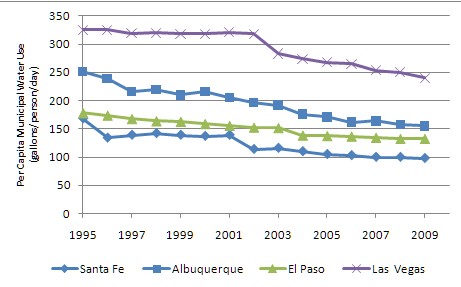A recent article in Choice Magazine reveals some interesting trends and attitudes on water usage in New Mexico. Below are a few excerpts from this excellent paper published by Brian Hurd. As is shown in this analysis, it is very possible for these communities in New Mexico to greatly decrease water usage, simply by targeting inefficient outdoor irrigation practices. No change in behavior required, just fix what is broken to save water and save money. These levels of water savings are probably not unique to New Mexico, but probably apply to all areas where the irrigation season is the peak water demand season.
Communities throughout the arid western United States and in growing numbers in the relatively more water-abundant east are challenged by increasingly scarce water supplies, growing populations, and needed economic development. Communities desire secure, reliable water supplies, as well as a varied array of attractive public amenities including parks, open spaces, swimming and recreation facilities, public golf courses, and other water-intensive services. Water managers must balance these desires with the growing costs of system maintenance and expansion, all the while generating sufficient revenues to service these costs.

Economic incentives--such as increasing block rate structures where per unit water prices are higher for higher volumes consumed and rebates for water-saving appliances, fixtures, and landscapes--alone do not appear to explain the relative success that communities have achieved in reducing per capita water use.
Resistance to higher water rates and limited program resources for financial incentives means greater reliance on noneconomic approaches and public appeals for wise-use and 'correct' behavior.
Irrigating the urban residential landscape usually accounts for 40-70% of household water use. Additionally, residential landscapes receive 30 to 40% more water than typically required by the common types of plants and grass. Estimates of potential water savings range from 35% to 75% of current per capita water use based on a typical home with a traditional bluegrass type landscape (Sovocool, 2005). Improvements in the efficiency of landscape irrigation could yield significant water savings and is properly the focus of municipal water conservation programs.
Read the full article: Water-Conserving Attitudes and Landscape Choices in New Mexico
Communities throughout the arid western United States and in growing numbers in the relatively more water-abundant east are challenged by increasingly scarce water supplies, growing populations, and needed economic development. Communities desire secure, reliable water supplies, as well as a varied array of attractive public amenities including parks, open spaces, swimming and recreation facilities, public golf courses, and other water-intensive services. Water managers must balance these desires with the growing costs of system maintenance and expansion, all the while generating sufficient revenues to service these costs.

Economic incentives--such as increasing block rate structures where per unit water prices are higher for higher volumes consumed and rebates for water-saving appliances, fixtures, and landscapes--alone do not appear to explain the relative success that communities have achieved in reducing per capita water use.
Resistance to higher water rates and limited program resources for financial incentives means greater reliance on noneconomic approaches and public appeals for wise-use and 'correct' behavior.
Irrigating the urban residential landscape usually accounts for 40-70% of household water use. Additionally, residential landscapes receive 30 to 40% more water than typically required by the common types of plants and grass. Estimates of potential water savings range from 35% to 75% of current per capita water use based on a typical home with a traditional bluegrass type landscape (Sovocool, 2005). Improvements in the efficiency of landscape irrigation could yield significant water savings and is properly the focus of municipal water conservation programs.
Read the full article: Water-Conserving Attitudes and Landscape Choices in New Mexico
Continue reading Water-Conserving Attitudes and Landscape Choices in New Mexico.


